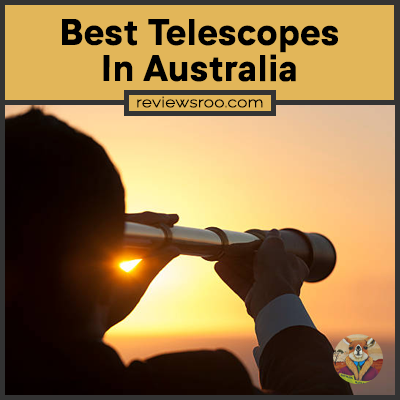Best Telescopes In Australia
Have you ever wondered what it would be like to explore the stars? To take a look at distant planets, or even galaxies far away? Telescopes can make this dream a reality.

Whether you’re an experienced astronomer, or just a beginner looking for your first telescope, this article will provide an overview of some of the best telescopes on the market today.
We’ll discuss the features and specifications of each telescope, so that you can decide which one is best for your needs. We’ll also offer our opinion on what makes each telescope a good choice. With these tips in mind, you’ll be able to make an informed decision about which telescope is right for you.
So if you’re ready to start your journey through space and time, read on to find out about some of the best telescopes available!
Top Pick: The Celestron 21049 Seeker Telescope Reflector

The Celestron 21049 Seeker Telescope Reflector is a budget-friendly option that caters to the needs of beginners in the world of stargazing. With its impressive features and affordability, this telescope opens up a whole new world of celestial exploration.
Versatile Reflector Design: The telescope’s reflector design offers excellent light-gathering capabilities, allowing for clear and detailed views of celestial objects. Its large aperture ensures enhanced brightness and sharper images, making it ideal for observing planets, stars, and even deep-sky objects.
Sturdy Build and Easy Setup: Crafted with durability in mind, the Celestron 21049 Seeker Telescope is built to last. It features a stable and sturdy mount, ensuring steady observations without excessive vibrations. Additionally, its user-friendly setup makes it accessible for beginners, allowing them to start observing the night sky with minimal effort.
Enhanced Accessories for Optimal Viewing Experience: This telescope comes equipped with several useful accessories that enhance the overall stargazing experience. The included eyepieces and a Barlow lens provide different magnification options, while the finderscope aids in locating celestial objects with precision.
Pros:
- Impressive Optics
- Affordable Price Point
- Beginner-Friendly Features
Cons:
- Limited Portability
- Basic Accessories
The Telescopes Refractor Astronomy Telescope

The Telescopes Refractor Astronomy Telescope is a budget-friendly option that caters to beginners in the field of astronomy. With its compact design and user-friendly features, this telescope opens up a world of celestial wonders without breaking the bank.
Compact and Portable: The Telescopes Refractor Astronomy Telescope features a compact and lightweight design, making it easy to transport and set up for stargazing sessions. Its portability allows users to take their telescope to various locations and explore different celestial phenomena.
Versatile Refractor Optics: Equipped with high-quality refractor optics, this telescope offers crisp and detailed views of celestial objects. Whether observing the Moon, planets, or distant star clusters, the telescope’s optics deliver impressive clarity and contrast.
Easy Assembly and Operation: Designed with beginners in mind, this telescope offers a straightforward assembly process and intuitive controls. Even those new to astronomy can quickly set up the telescope and start exploring the night sky with ease.
Pros:
- Clear and Detailed Views
- Affordable Price
- Portable and Convenient
Cons:
- Limited Aperture
- Basic Accessories
Orion 10012 SkyScanner Reflector Telescope

The Orion 10012 SkyScanner Reflector Telescope is a compact and powerful option for amateur astronomers looking to delve into the wonders of the night sky. With its impressive features and user-friendly design, this telescope offers an excellent entry point into celestial exploration.
Compact and Portable Design: The Orion 10012 SkyScanner Reflector Telescope boasts a compact and lightweight design, making it easy to transport and set up. Its portable nature allows users to enjoy stargazing sessions in various locations, making it ideal for both backyard observations and remote stargazing adventures.
Impressive Optics for Clear Views: Equipped with high-quality reflector optics, this telescope provides clear and detailed views of celestial objects. Its ample aperture and focal length allow for sharp and bright images, making it suitable for observing the Moon, planets, and deep-sky objects.
Beginner-Friendly Features: Designed with beginners in mind, this telescope features simple and intuitive controls, allowing users to easily navigate the night sky. The included accessories and helpful guide make it an excellent choice for those new to astronomy.
Pros:
- Optimal Performance
- Easy Setup and Use
- Portable and Versatile
Cons:
- Limited Magnification Options
- Tripod Stability
Orion StarBlast Equatorial Reflector Telescope

The Orion StarBlast Equatorial Reflector Telescope is a versatile and powerful instrument designed to captivate both novice and experienced astronomers. With its exceptional features and sturdy construction, this telescope provides an immersive stargazing experience for those eager to explore the depths of the universe.
Enhanced Equatorial Mounting System: The Orion StarBlast Equatorial Reflector Telescope features a robust equatorial mounting system that enables precise tracking and smooth movement of the telescope. This system allows for accurate alignment with celestial objects, making it easier to observe and follow targets across the night sky.
High-Quality Optics for Superb Views: Equipped with high-quality reflector optics, this telescope delivers remarkable clarity and detail in celestial observations. Its generous aperture and focal length provide enhanced light-gathering capabilities, allowing for impressive views of planets, star clusters, and even fainter deep-sky objects.
Compact and Portable Design: Despite its powerful performance, the Orion StarBlast Equatorial Reflector Telescope is remarkably compact and portable. Its manageable size and lightweight construction make it convenient for both backyard observations and on-the-go stargazing adventures.
Pros:
- Precise and Stable TrackingImage Quality
- Versatile and Portable
Cons:
- Learning Curve for Beginners
- Assembly Time
Types Of Telescopes
The night sky has been a source of mystery, inspiration, and awe since the dawn of time. Every single star in the sky comes with an untold story, and unlocking them all is a challenge unlike any other. With the right telescope, you can explore these distant worlds and unlock their secrets – if you know what type to choose.
From refractors to reflectors, there are many types of telescopes that receive light from different sources. Refractors use lenses to form an image while reflectors have mirrors that capture light from distant stars. Compound telescopes combine both elements for a more powerful viewing experience. Each one offers its own advantages and disadvantages, so it’s important to choose the right one for your needs.
Optics And Magnification
Telescopes have come a long way since Galileo’s first telescope in 1609. The power of magnification has increased significantly in the past few centuries; modern telescopes can magnify objects up to 2000 times, allowing us to view distant galaxies and other cosmic wonders with remarkable clarity.
Optics, or lenses and mirrors, play an essential role in the quality of a telescope. Generally speaking, a larger lens or mirror will produce more light-gathering capability, which results in higher resolution images. Telescopes that use mirrors are particularly good for viewing faint objects, as they can increase brightness levels with greater accuracy than lenses can. Optics can be used to correct for aberrations and focus light correctly too, providing sharper images for observers.
Mounts And Tripods
Mounts and tripods are essential for any telescope. They provide the stability needed to hold the scope in place while allowing easy maneuverability. When deciding what mount and tripod to get, there are a few factors to consider:
- Weight – The mount should be heavy enough to keep the telescope steady but light enough that it is portable.
- Size – Make sure the mount is suitable for your telescope’s size and weight.
- Compatibility – Check if your mount is compatible with the type of telescope you have.
- Cost – Consider how much you want to spend on your mount and tripod.
Ultimately, choosing the right mount and tripod can make or break an astronomical experience. The right combination will provide a steady base that ensures clear images while still being easy to move when needed. Furthermore, many mounts come with accessories like tracking motors, which will help keep objects in focus as they move across the sky. With careful consideration, one can find a setup that meets both their needs and budget.
Accessories For Telescopes
A telescope is like an open window, a portal to explore the distant reaches of the universe. But it’s not just the hardware that makes these machines so powerful – accessories make all the difference.
From eyepieces to filters and more, the right extras can turn a basic telescope into a powerful tool for exploration. Each accessory serves its own purpose, allowing users to take full advantage of their instruments for maximum performance.
Eyepiece lenses magnify images and expand your field of view, while filters reduce glare or provide better visibility in certain regions of the sky. There are also adapters to connect your phone or camera for astrophotography, as well as motorized mounts designed to track objects across the night sky. With these add-ons, you can get more out of your telescope than ever before – and with it comes a greater appreciation for the wonders of space.
For those looking to take their stargazing even further, cost considerations come into play when choosing which accessories are right for them…
Cost Considerations For Telescopes
Cost is an important factor when buying a telescope. Telescopes can range from $100 to thousands of dollars. It pays to research and compare prices between stores and online retailers. Look for discounts, too.
When budgeting for a telescope, consider other expenses such as lenses, filters, eyepieces, mounting equipment and software. These will add up quickly and can be even more expensive than the telescope itself. Be sure to include those costs in your budget so you don’t get any unpleasant surprises later on.
It’s clear that cost is an essential part of the decision-making process when purchasing a telescope. The next step is to look at what types of telescopes are best suited for beginners.
Telescopes For Beginners
It was like a journey of discovery, the first time someone looked at the night sky through a telescope. A sense of wonder filled the air as galaxies and stars became visible to the eye. The experience can be made even better when finding the right telescope for beginners.
Choosing a telescope for a beginner is an important decision that requires careful consideration. There are several different types of telescopes available and it is key to choose one that is appropriate for the intended purpose. Telescopes designed for astronomy typically have larger lenses and more advanced features than those designed for general use. Beginners should also take into account cost as well as ease of use when selecting their first telescope. A good option for those who are just starting out may be to buy a smaller, less powerful telescope or rent one before investing in a more expensive model.
Finally, with some patience, research, and guidance from an experienced astronomer, anyone can find the perfect telescope to suit their needs. With the right setup, they will soon be gazing up at night’s wonders with newfound clarity and appreciation.
Telescopes For Astrophotography
To the untrained eye, it may appear that astrophotography requires a telescope of mythical proportions. But the truth is, you don’t need to break the bank in order to get a good telescope for shooting stars. In fact, there’s a whole range of telescopes designed specifically for astrophotography.
While some telescopes may be more affordable than others, they all offer an array of features that make them ideal for capturing stellar images. Telescopes that are built for astrophotography typically have long focal lengths and fast focal ratios – both of which are vital for getting sharp images. Additionally, these types of telescopes come with tracking motors or computerized mounts so you can capture long exposures without having to constantly adjust the scope manually.
The next step will provide insight into computerized telescopes and the advantages they can bring to your astrophotographic pursuits.
Computerized Telescopes
Computerized telescopes offer convenience and accuracy. They have the ability to automatically locate objects in the night sky. And with a few clicks of a button, you can easily point your telescope at any desired celestial body.
These models usually come with a computerized hand control which offers access to a database of over 40,000 astronomical objects. The technology makes it possible to track objects as they move through the night sky, keeping them in view while you observe them or take photographs. Some even feature built-in Wi-Fi connectivity so you can update your device’s software and add new features remotely.
Computerized telescopes are great for beginners who want an easier way to learn about astronomy without having to worry about manually slewing their equipment around the sky. They also make it easy for experienced users to explore and study distant galaxies and other deep space phenomena with greater accuracy and convenience. With these amazing devices, amateur astronomers of all levels can enjoy exploring the night sky like never before.
Portable Telescopes
Portable telescopes are a great option for the amateur stargazer. Small and lightweight, they’re easy to carry and set up in any location. And unlike their larger counterparts, computerized telescopes, they don’t need to be mounted on a tripod or remain stationary for optimal viewing. This makes them ideal for those who want to take their stargazing on the go.
However, portable telescopes do have some drawbacks. For one thing, they tend to be lower quality than computerized models; you’ll get less magnification and clarity out of them. They also require more maintenance and care than computerized models – which can be tricky if you’re not used to handling delicate optics.
Taking proper care of your telescope is essential if you want to get the most out of it. Keeping it clean, stored properly when not in use, and regularly checking for damage will ensure that it lasts longer and performs better over time.
Maintenance And Care Of Telescopes
Caring for a telescope is an important part of owning one. It’s not enough to simply buy the best telescope – proper maintenance and attention must be given in order for it to last. That’s why this article will discuss the essential steps for taking care of your telescope.
When caring for your telescope, it’s important to keep it clean. Dust can gather over time, blocking the lenses and interfering with images. To prevent this, use a soft cloth and gentle cleaning fluid to wipe away any dust that builds up on the lens or body of the telescope. Additionally, you should check regularly check any screws and connections to make sure they are secure and not coming loose – if they do, tighten them up right away.
Maintaining your telescope can also involve protecting it from external elements, such as rain or snow. When storing your telescope, always keep it in a dry place, such as a closet or cabinet, to prevent moisture from damaging its sensitive parts. Additionally, you should never leave your telescope outside overnight – this could cause damage due to temperature changes or exposure to harsh weather conditions. Taking these protective measures will ensure that your telescope lasts for many years to come.
Frequently Asked Questions
What Are The Differences Between A Refractor And A Reflector Telescope?
Refractor and reflector telescopes offer different advantages. Take, for example, the Galileo refractor telescope. It offers a powerful observing experience with great portability. The main difference between a refractor and a reflector is how light is collected and focused. Refractors use lenses to bend light into an image, whereas reflectors use mirrors to create an image.
Refractors tend to be smaller and more portable than reflectors. They usually have shorter focal lengths, which makes them better suited for terrestrial viewing than their counterparts. However, they are not as good at observing faint objects in the night sky due to chromatic aberration caused by the lenses used in these designs.
Reflectors tend to be larger but can provide brighter, sharper images due to the absence of chromatic aberration from using mirrors instead of lenses. Mirrors also have longer focal lengths which means they are better suited for deep space objects like galaxies and nebulae that require higher magnifications than what a refractor can offer. TIP: Before buying any telescope, make sure you understand the differences between refractors and reflectors so you get the most out of your stargazing experience!
What Is The Best Telescope For A Beginner?
Every beginner astronomer needs to consider what type of telescope is best for them. Take Joe, for example: he’s recently become interested in astronomy and wants to purchase a telescope. What should he buy?
A beginner should look for a telescope that is easy to operate and set up. Refractors or reflectors are often the best choice because they don’t require advanced knowledge of optics and usually come with a tripod mount. They also tend to be lighter than other types of telescopes, making them easier to transport.
So which is better – refractor or reflector? That depends on how much money you’re willing to spend, as well as what kind of viewing experience you want. Refractors have lenses that provide crisp images but can be quite expensive; reflectors have mirrors that are cheaper, but require more time spent aligning the optics in order to get clear images. Ultimately, if you are just starting out and on a budget, then a reflector would probably be the best choice for you.
Whichever type of telescope you decide on, make sure it has good quality optics and comes with accessories like eyepieces – these will help you get the most out of your viewing experience! With some research and careful consideration, Joe (and anyone else looking for their first telescope) can find the perfect fit for their budget and needs.
What Is The Most Important Accessory For A Telescope?
If you want to be a stargazer, the most important accessory for your telescope is not just eye-catching, but soul-stirring. It’s so essential that without it, you won’t even be able to find your way around the night sky! That accessory is a star chart – an absolute must-have if you’re serious about astronomy.
Star charts are like maps of the sky; they show you the way to planets, stars and other celestial bodies in an instant. No matter what type of telescope you use, whether it’s a refractor or reflector, these charts can help pinpoint precisely where the objects are located. They also come with handy labels and notes to help identify them quickly. Plus, they’re incredibly easy to use and can be used anywhere.
So if exploring the night sky is on your wish list, don’t forget to add this invaluable tool to your collection – it’s one of those rare accessories that will take your star gazing experience from good to great!
What Is The Best Telescope For Astrophotography?
A telescope is like a keyhole to the universe, unlocking distant galaxies and star clusters that would otherwise remain invisible. When it comes to capturing these cosmic wonders, astrophotography is the way to go. But what is the best telescope for astrophotography?
When looking for a telescope specifically for astrophotography, you should look for one with a large aperture. The bigger the aperture, the more light it can collect and produce sharper images. Higher magnification is also important as this will allow you to zoom in on those faint objects in deep space. Lastly, do not overlook the importance of tracking accuracy – this ensures that your images stay sharp even when you’re zooming in on distant galaxies.
TIP: Before buying a telescope, read reviews online to get an idea of how it performs and how satisfied users are with its performance. Doing research ahead of time will help save you from making a costly mistake!
Does A Computerized Telescope Make It Easier To Locate Stars?
Astrophotography requires a telescope to capture images of stars and other celestial objects. But does a computerized telescope make it easier to locate stars?
It’s true that a computerized telescope has some advantages. It can be programmed with star maps and operated automatically, reducing the amount of time needed to set up and adjust the telescope for star-gazing. It also helps to pinpoint the exact location of stars in the night sky. But this doesn’t mean that non-computerized telescopes are obsolete.
Non-computerized telescopes still have a place in astrophotography, as they provide an intuitive experience and allow users to get more familiar with the night sky. They also offer better optics than computerized models, providing sharper images of stars and planets. So there are pros and cons to both types of telescopes when it comes to locating stars for astrophotography projects. Ultimately, it will depend on what kind of experience you’re looking for and what type of equipment best fits your needs.
Conclusion
To wrap things up, the best telescope for any individual can depend on their goals and budget. With so many options out there, it’s important to do some research before making an investment.
A refractor telescope is great for beginners. It’s generally more affordable than a reflector, and its optical tube is easier to use. Plus, its portability makes it perfect for viewing stars from anywhere. If astrophotography is your goal, then a reflector telescope with a larger aperture will be your best bet. For even better results, consider investing in a computerized telescope that’ll make it easier to locate stars and planets in the night sky.
No matter what kind of telescope you choose, make sure you get the right accessories to enhance your experience like eyepieces and filters that will help you explore the stars like never before. Investing in a quality telescope will open up a brand new world of astronomical discovery!





